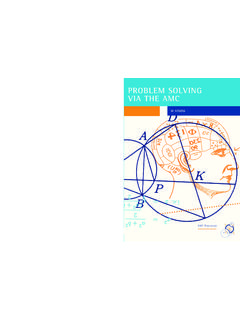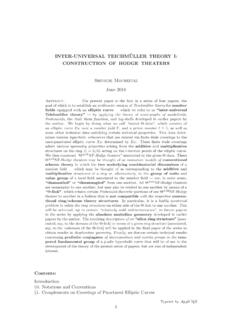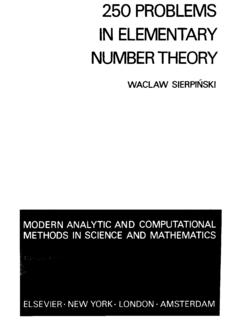Transcription of EECE 460 : Control System Design - SISO Pole …
1 EECE 460 : Control System DesignSISO pole PlacementGuy A. DumontUBC EECEJ anuary 2011 Guy A. Dumont (UBC EECE)EECE 460: pole PlacementJanuary 20111 / 29 Contents1 Preview2 Polynomial pole Placement3 Constraining the Solution4 PID Design5 Smith PredictorGuy A. Dumont (UBC EECE)EECE 460: pole PlacementJanuary 20112 / 29 PreviewPreviewFormal Control Design methodThe key synthesis question is:Given a model, can one systematically synthesize a controller such that theclosed-loop poles are in predefined locations?This is indeed possible through pole assignmentIn EECE360, we saw a method for assigning closed-loop poles throughstate feedback (see review notes)Here we shall see a polynomial approach based on transfer functionsThis material is covered in Chapter 7 of the textbookGuy A.
2 Dumont (UBC EECE)EECE 460: pole PlacementJanuary 20113 / 29 Polynomial pole PlacementPolynomial pole PlacementConsider the nominal plantG0(s) =B0(s)A0(s)and the controllerC(s) =P(s)L(s)in a simple feedback configuration as belowGuy A. Dumont (UBC EECE)EECE 460: pole PlacementJanuary 20114 / 29 Polynomial pole PlacementThe Design ObjectiveConsider a desired closed-loop polynomialAcl(s) =acncsnc+acnc 1snc 1+ +ac0 Design ObjectiveGiven A0and B0, can we find P and L such that the closed-loop characteristicpolynomial is Acl(s)?The characteristic equation 1+G0C=0 gives the characteristicpolynomialA0L+B0P. Does there existP(s)andL(s)such thatA0(s)L(s)+B0(s)P(s) =Acl(s)Guy A. Dumont (UBC EECE)EECE 460: pole PlacementJanuary 20115 / 29 Polynomial pole PlacementA Simple ExampleLetA0(s) =s2+3s+2 andB0(s) =1 ConsiderP(s) =p1s+p0andL(s) =l1s+l0 ThenA0(s)L(s)+B0(s)P(s) = (s2+3s+2)(l1s+l0)+(p1s+p0)LetAcl(s) =s3+3s2+3s+1 Equating coefficients givesGuy A.
3 Dumont (UBC EECE)EECE 460: pole PlacementJanuary 20116 / 29 Polynomial pole PlacementA Simple ExampleThe above 4 4 matrix is non-singular, hence it can be inverted and wecan solve forp0,p1,l0andl1 Doing so, we findl0=0,l1=1,p0=1 andp1=1 Hence the desired characteristic polynomial is achieved by the controllerC(s) =P(s)L(s)=s+1sNote that this is a PI controller!Note that in order to solve for the controller, a particular matrix has to benon-singularThis matrix is known as the Sylvester matrixGuy A. Dumont (UBC EECE)EECE 460: pole PlacementJanuary 20117 / 29 Polynomial pole PlacementSylvester s TheoremTheorem (Sylvester s Theorem)Consider the two polynomialsA(s) =ansn+an 1sn 1+.
4 +a0B(s) =bnsn+bn 1sn 1+..+b0and the eliminant matrix (also known as Sylvester matrix)Then A(s)and B(s)are coprime ( have no common factors) if and only ifdet(Me)6=0 Guy A. Dumont (UBC EECE)EECE 460: pole PlacementJanuary 20118 / 29 Polynomial pole PlacementPole placement DesignLemma ( pole placement Design )Consider the feedback loopwith G0(s) =B0(s)A0(s)and C(s) =P(s)L(s)Assume A0(s)and B0(s)are coprime with n=degA0(s)Let Acl(s)be an arbitrary polynomial of degree nc=2n , there exist P(s)and L(s)with degrees np=nl=n 1such thatA0(s)L(s)+B0(s)P(s) =Acl(s)Guy A. Dumont (UBC EECE)EECE 460: pole PlacementJanuary 20119 / 29 Polynomial pole PlacementThe Diophantine EquationThe equationA0(s)L(s)+B0(s)L(s) =Acl(s)is called Diophantine equation after Greek mathematician its matrix form, it is also referred to as the Bezout Identity.
5 It plays acentral role in modern Control previous Lemma presents the solution for the minimal controller is said to be biproper, degP(s) =degL(s)Usually, the polynomialsA0(s),L(s)andAcl(s)are monic coefficientof highest power ofsis , often known as the father of algebra , is best known for his Arithmetica, awork on the solution of algebraic equations and on the theory of numbers. However, essentiallynothing is known of his life and there has been much debate regarding the date at which A. Dumont (UBC EECE)EECE 460: pole PlacementJanuary 201110 / 29 Constraining the SolutionForcing IntegrationAs seen before, it is very common to force the controller to contain anintegratorTo achieve this, we need to rewrite the denominator of the controller asL(s) =s L(s)The Diophantine equationA0(s)L(s)+B0(s)P(s) =Acl(s)A0(s)s L(s)+B0(s)P(s) =Acl(s)can then be rewritten asForcing Integration A0(s) L(s)+B0(s)P(s) =Acl(s)with A0(s) =sA0(s)Guy A.
6 Dumont (UBC EECE)EECE 460: pole PlacementJanuary 201111 / 29 Constraining the SolutionForcing IntegrationNote that because we have increased the degree of the by 1, nowwe have degAcl=2nand need to add a closed-loop , since degL=deg L+1, to keep a bi-proper controller, we shouldhave degP=degL=deg L+1 Guy A. Dumont (UBC EECE)EECE 460: pole PlacementJanuary 201112 / 29 Constraining the SolutionForcing pole /Zero CancellationSometimes it is desirable to force the controller to cancel a subset ofstable poles or zeros of the plant modelSay we want to cancel a process pole at p, the factor(s+p)inA0,thenP(s)must contain(s+p)as a the Diophantine equation has a solution if and only if(s+p)is alsoa factor ofAclTo solve the resulting Diophantine equation, the factor(s+p)is simplyremoved from both sidesGuy A.
7 Dumont (UBC EECE)EECE 460: pole PlacementJanuary 201113 / 29 Constraining the SolutionExample 1 Consider the systemG0(s) =3(s+1)(s+3)The unconstrained problem calls for degAcl=2n 1=3. ChooseAcl(s) = (s2+5s+16)(s+40). The polynomialsPandLare of degree1. The Diophantine equation is(s+1)(s+3)(s+l0)+3(p1s+p0) = (s2+5s+16)(s+40)which yieldsl0=41,p1=49/3 andp0=517/3 and the controllerC(s)isC(s) =49s+5173(s+41)Guy A. Dumont (UBC EECE)EECE 460: pole PlacementJanuary 201114 / 29 Constraining the SolutionExample 1 Consider now the constrained case where we want the controller tocontain integration. We need to add a closed-loop pole . Let us say thatwe want the controller to cancel the process pole at 1.
8 The Diophantineequation then becomes(s+1)(s+3)s(s+l0)+3(s+1)(p1s+p0) = (s+1)(s2+5s+16)(s+40)which after eliminating the common factor(s+1)yieldsl0=42,p1=30 andp0=640/3 and the controllerC(s)isC(s) =(s+1)(90s+640)3s(s+42)Guy A. Dumont (UBC EECE)EECE 460: pole PlacementJanuary 201115 / 29 Constraining the SolutionExample 2 Assume the plant with nominal modelG0(s) =1s 1We want a controller that stabilizes the plant and tracks with zerosteady-state error a 2 rad/s sinusoidal reference of unknown amplitudeand phaseThe requirement for zero steady-state error at 2 rad/s impliesT0( j2) =1 S0( j2) =0 G0( j2)C( j2) = This can be satisfied if and only ifC( j2) = , ifC(s)has poles at j2 ThusC(s) =P(s)L(s))=P(s)(s2+4) L(s)Guy A.
9 Dumont (UBC EECE)EECE 460: pole PlacementJanuary 201116 / 29 Constraining the SolutionExample 2 Since we have added 2 poles to the controller, we now needdegAcl=2n 1+2=3, degP(s) =2 and deg L=0 This leads to L(s) =1 andP(s) =p2s2+p1s+p0 ChoosingAcl(s) = (s2+4s+9)(s+10), the Diophantine equation is A0(s) L(s)+B0(s)P(s) =Acl(s(s 1)(s2+4)+(p2s2+p1s+p0) = (s2+4s+9)(s+10)s3+(p2 1)s2+(p1+4)s+p0 4=s3+14s2+49s+90 This yieldsp2=15,p1=45,p0=94, (s) =15s2+45s+94(s2+4)This is not a PID!Guy A. Dumont (UBC EECE)EECE 460: pole PlacementJanuary 201117 / 29 PID DesignPole- placement PID DesignWe already have seen how to derive a PID controller using amodel-based technique such as the Dahlin controller, which is actually aspecial case of pole placement .)
10 Here we generalize this designLemmaThe controllerC(s) =n2s2+n1s+n0d2s2+d1sand the PIDCPID(s) =KP+KIs+KDs Ds+1areequivalent whenKP=n1d1 n0d2d21KI=n0d1KD=n2d21 n1d1d2+n0d22d31 D=d2d1 Guy A. Dumont (UBC EECE)EECE 460: pole PlacementJanuary 201118 / 29 PID DesignPole- placement PID DesignTo obtain a PID controller, we then need to use a delay-free second-ordernominal model for the plant and Design a controller forcing integrationWe thus choosedegA0(s) =2degB0(s) 1deg L(s) =1degP(s) =2degAcl=4 Guy A. Dumont (UBC EECE)EECE 460: pole PlacementJanuary 201119 / 29 PID DesignExample 3 Consider the nominal plantG0(s) =2(s+1)(s+2)Synthesize a PID that gives closed-loop dynamics dominated by(s2+4s+9)Adding the factor(s+4)2to the above so that degAcl=4 WithB0(s) =2 andA0(s) =s2+3s+2 the following controller isobtainedC(s) =P(s)s L(s)=14s2+59s+72s(s+9)From the previous Lemma we find that this a PID controller withKP= D= A.







